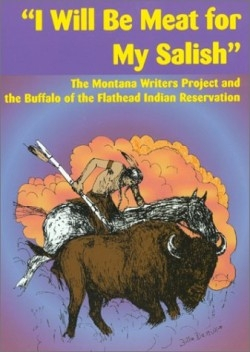"I Will Be Meat for My Salish"
The Montana Writers Project and the Buffalo of the Flathead Indian Reservation
Walking Coyote, a Pend d’Oreille Indian from western Montana, circa 1878, was in trouble. He already had a wife, but he took a second, risking the disappointment of the fathers of the St. Ignatius Mission and punishment by his tribe. As a peace offering, he captured several buffalo calves and brought them across the mountains to Flathead country.
Though the details have varied over the years, that is the beginning of the story of how a small buffalo herd on the Flathead Reservation played a critical role in preventing the entire extinction of the American bison. It’s but one subject in this book, which examines the culture of the Salish Indians, who were once the main inhabitants of parts of present-day Idaho, Montana, Oregon, Washington, and British Columbia. In the late 1930s and early ‘40s, Salish elders were interviewed about their legends, history, and way of life as part of the Works Progress Administration’s Montana Writers Project. The buffalo, of course, played an extremely important role.
The book’s title comes from the myth of the Sun Buffalo Cow, who sacrificed her life to feed the starving Indians. Changing into an earth buffalo, she jumped from a cliff so that there would be food: “I will be meat for my Salish.”
The author, a Quaker who came to the Flathead Indian reservation lands in 1910 when he was nineteen, was a farmer and lumberman who died in 1959. Interested in genealogy and the history and customs of the people native to the region, he began interviewing elderly Salish as early as the 1920s.
Many of the stories concern the Pablo-Allard herd, the descendants of those original calves brought to Flathead lands. The herd roamed freely there for nearly thirty years until the reservation lands were opened up to non-Indians in 1905. Wanting to preserve the herd, Michel Pablo asked the government for help. With none forthcoming, the buffalo—numbering around 700—were sold to Canada. The ensuing roundup took nearly three years and was a big event in the region, drawing spectators from all over.
At the back of the book are brief biographies of those interviewed, an excellent supplement to the stories.
Disclosure: This article is not an endorsement, but a review. The publisher of this book provided free copies of the book to have their book reviewed by a professional reviewer. No fee was paid by the publisher for this review. Foreword Reviews only recommends books that we love. Foreword Magazine, Inc. is disclosing this in accordance with the Federal Trade Commission’s 16 CFR, Part 255.

